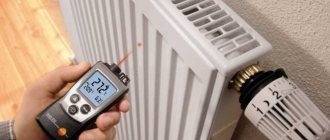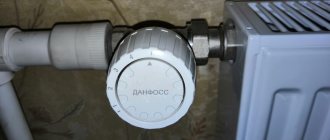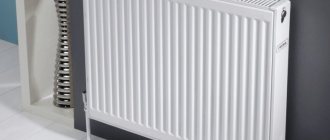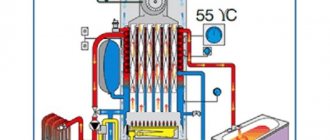Heating system plumbing fixtures are an integral part of any living space. A comfortable microclimate depends on them. According to regulatory documents, maintenance and repair of this equipment is carried out in the spring and summer, when the coolant supply stops. But sometimes unforeseen circumstances arise, and urgent replacement of heating radiators is required during the heating season.
Reasons for replacing batteries and pipes during the heating season
There are no provisions in the current legislation prohibiting the replacement of batteries during the heating season. The reasons that make it possible to carry out actions are not given. The need to replace heating radiators arises due to the following reasons:
- there is a leak;
- the apartment is cold;
- a person wants to replace the batteries with new ones.
It’s easier if the radiator is separated from the general system by taps that allow you to turn off the water and actually disconnect the section intended for replacement from the heating system. As a result, you can do whatever you want with it.
The situation is more complicated when there is no overlap. You'll have to block the riser. To do this, you will need to obtain permission from the management company.
Important! The organization is obliged to comply with the provisions of the Decree of the Government of the Russian Federation dated May 6, 2011 No. 354. It reflects the permissible duration of the heating interruption.
According to the law, the period for stopping the heating supply is:
- in total no more than a day within 30 days;
- no more than 16 hours at a time if the air temperature in residential premises is above 12 degrees;
- no more than 8 hours at a time, when the air temperature in the apartment is 10-12 degrees;
- no more than 4 hours at a time if the air temperature is 8-10 degrees.
If the above period is exceeded, the utility fee is reduced by 0.15%.
Management companies are reluctant to agree to give permission to shut off risers. Moreover, institutions approve applications if the work is performed by their plumbers. Otherwise, the citizen may be asked to collect signatures from residents confirming that they are not against temporarily turning off the heating. It's quite difficult.
Therefore, if you plan to replace pipes during the heating season, then you need to be prepared for additional costs, since plumbers of management companies charge an order of magnitude higher than specialists not related to the organization.
The process of turning off the heating riser
Since the heating system requires regular monitoring of its condition, its operation must be monitored by the owners of residential premises.
Also, repairs and maintenance can be carried out by a management company with which a corresponding agreement is concluded. According to Article 36, Part 2 of the Housing Code of Russia, the heating riser belongs to the common property of a residential apartment building.
If it is necessary to dismantle, repair or replace heating radiators, the homeowner submits an application to the management company.
A list of required documents is attached to the application, and the specialists identified in the application can begin working with the heating system. The management company turns off the heating riser to avoid an emergency.
Step-by-step instruction
If a person wants to replace the battery or heating pipes in an apartment, it is recommended to follow the step-by-step instructions. This will reduce the risk of errors. It is important to follow the diagram:
- The work is being coordinated with utility services. The procedure can be carried out without their permission only if there is no interruption in the heating supply to other apartments.
- If permission is received, a plumber is called. He will dismantle the old ones and then install new radiators.
- Conducting tests. If the heating is working, the system is put into operation.
- It is important to act quickly. Interruptions in the heating supply for a long period of time are unacceptable. The period during which the work must be completed varies from 4 to 16 hours and depends on the temperature in the apartments. The management company will not allow you to turn off the heating for a longer period. It takes a plumber about 1-2 hours to complete all the work.
Healthy! Read the material on the topic: how to get rid of air locks in heating radiators and why noise in radiators is dangerous.
Disabling the heating riser: when it may be necessary
There are a number of situations in which it may be possible to limit the functioning of pipes in the heating system. An apartment building implies the constant presence of liquid in the batteries. This could be water or antifreeze.
In summer the liquid is cold, and in winter it is hot. It is due to the high temperature of this liquid that the rooms are maintained warm.
It may be possible to turn off the heating riser if the following situations occur:
- installation of new radiators or their removal for maintenance and repair;
- repair work in the heating system;
- replacing fluid in the riser.
Turning off the heating riser due to a change of fluid in it is rarely done, since the less the inner surface of the pipes comes into contact with air, the longer the time it will be in working condition. Radiators inside are subject to corrosion; the degree of this destructive process directly depends on the type of material of the heating device. You can read about the differences between radiators made of steel, cast iron and aluminum, their advantages and disadvantages in the following article on our website.
Where to contact
You must first obtain permission to replace batteries. To do this, a statement is written to the Housing Office. Additionally, you will need to provide certificates of conformity for radiators and components.
Note! If the batteries are replaced with structures that entail an increase in the heating area, representatives of the management company may require an examination to understand how the heat balance of the building will change.
A similar procedure is carried out if a major renovation is carried out in the apartment and the pipeline configuration is changed. Work must be carried out in compliance with municipal legislation. In another situation, they may be considered a violation.
Replacing heating radiators in winter
How to choose the right radiator
There are only 2 fundamental criteria: design and heat transfer. In terms of the second indicator, cast iron batteries remain unsurpassed, although aesthetically they look unattractive. But in modern stores you can also find artistic cast iron. Such devices are heavier than conventional ones, but they also heat better, and they don’t care about water hammer (sharp pressure drop), and besides, they look beautiful.
There is a growing popularity of bimetallic radiators, which perfectly resist corrosion and fit harmoniously into almost any interior. Manufacturers offer both wall-mounted and floor-mounted options. Such devices are connected using polypropylene pipes, the service life of which is 50 years. Elegant products look beautiful and last a long time.
To make the indoor microclimate comfortable, you will need to perform a simple calculation. First, the number of connecting devices is determined. For example, the area of the room is 20 square meters. m. To heat every 2 meters, there is 1 section and 1 additional section for the entire room: 20: 2 + 1 = 11. A cast-iron device with so many elements will look cumbersome, a bimetallic one will look quite nice. But, if there are 2 windows in the room, it is better to place 2 batteries under them for 5 and 6 sections - this is the optimal solution.
Next, the amount of heat is calculated. It is different for each type of house.
The norm for heating one cubic meter of room is:
- for new buildings - 20 W;
- for brick buildings - 34 W;
- for panel buildings - 41 W.
Therefore, for the calculation it is necessary to know the heat transfer of one section. Let it be 100 W. We consider the volume of a room with an area of 20 square meters. m: 5 × 4 × 2.5 (ceiling height) = 50 m³. Let's say this is a new building. Then to heat the room you will need: 50 × 20 = 1000 W. We have 2 radiators with a total number of sections of 11. We multiply them by one hundred and get the result: 11 x 100 = 1100 W with the required 1000 W. Two batteries for 5 and 6 sections are quite enough to maintain a comfortable microclimate. Provided that there are no heat leaks through doors and windows.
Prices for heating radiators from different manufacturers
heating radiators
Price
Replacing batteries in an apartment during the heating season requires significantly higher costs. The cost of the procedure is affected by:
- the region in which the premises are located;
- an institution that will deal with battery replacement;
- equipment used.
In federal cities, the cost of services is much higher. Plumbers from private companies ask for about 5,000 rubles.
However, the management company will give permission if its specialist is involved in the replacement procedure. Due to the presence of a monopoly on plumbing services, prices are inflated. As a result, the management company employees ask for 8,000 rubles.
A number of organizations propose to carry out the replacement procedure without disconnecting the entire entrance from the heating. For this purpose, a pipe freezing unit is used. This is a rather massive and expensive instrument. It will lead to an increase in cost by at least another 1000 rubles. At the same time, there is a risk that the riser will freeze in the neighboring apartment. This may give rise to a complaint and subsequent proceedings.
Important! Disabling and draining the riser also requires payment of a fee. The price depends on the region and varies from 300 to 3000 rubles. for 1 hour of shutdown. The work is carried out by several employees at once.
Who makes the decision to turn off the heating?
Making a decision to stop the supply of heat to residential premises according to the general schedule, ahead of schedule or at a later date, is the prerogative of the municipality. After the exact date for turning off the heating has been set by order, the local thermal power plant carries out procedures to stop the equipment for its further inspection and preventive repairs in the off-season. Since the operation of stopping or starting heating networks is a costly and labor-intensive procedure, it cannot be carried out spontaneously.
Regional authorities are required to conduct a thorough analysis of the data before setting a date for turning off the heating.
Administration workers rely on the following data:
- an increase in the average daily air temperature to +8 °C is observed for 5 or more days;
- the forecast of the Hydrometeorological Center does not promise cold weather in the next 2 weeks;
- compliance with calendar dates - in the territory of the Russian Federation, heat supply is switched off from April to May.
Administration employees are required to notify the population using the services of city heating networks in advance about the decision to terminate the heating season early or extend it.
Sample documents
As mentioned earlier, the citizen will have to write an application to the Housing Office. The form of the document is not established in current legislation. Therefore, it is permissible to write an application arbitrarily. However, it is important to follow generally accepted business practices. Experts advise reflecting the following information in the document:
- information about the organization to which the appeal is sent;
- personal data of the applicant and residential address;
- document's name;
- a statement of the specifics of the situation;
- a request made to the institution;
- date of document preparation and signature.
Handwritten paperwork is acceptable. The signature is affixed by hand. Having received an appeal, representatives of the authorized body are obliged to respond. If the decision is positive, it is permissible to turn off the heating.
New cast iron batteries
If the advantages of a cast iron battery outweigh its disadvantages for you, we can recommend you high-quality modern cast iron batteries. In the Santekhbomba store you will find several practical options - the STI Nova 500 and STI Nova 300 models are presented to your attention. They differ from each other in size and power characteristics - for example, the “older” model 500 has a heat transfer of 150 W per section, section weight at the same time it is 4.2 kg, volume – 0.52 l. For the 300 model, these figures are respectively 120 W, 2.9 kg and 0.3 l, while it is 20 cm lower. Both radiators have an original design; a heat-resistant polymer coating is applied to the surface.
For those who prefer a familiar design, the classic MC-140 model is perfect. Consisting of 7 sections of 150 W each, it looks almost the same as “those” Soviet batteries. And, of course, it is still heavy, since it is made of real cast iron. However, you haven’t forgotten what advantages this material has, have you?
Is it possible to replace it yourself?
When figuring out how to change a heating battery yourself, a person will find out that the current legislation does not prohibit this action. If it is not necessary to shut off the riser for all apartments, a person has the right to complete the procedure without contacting the authorized bodies. The situation changes when, in order to replace the batteries, it is necessary to deprive the residents of other rooms of heat.
Only representatives of the management company have the right to block risers. It is better to use the services of specialists from the organization. The management company's plumbers know better the features of the utilities in the house and the location of the taps. As a result, specialists will be able to make replacements faster. Moreover, sometimes the application is approved only if the replacement is carried out by a plumber from the management company.
Normative base
The main document establishing the norms and rules for providing citizens of the Russian Federation with centralized heating through the provision of services of a single heat supply organization in 2022 is Federal Law No. 190 “On Heat Supply” dated July 27, 2010. The legislative act considers issues related to legal relations, the obligations of companies providing heat to citizens: how, in what time frame and to what extent they are carried out, what responsibilities the organization has for the timely repair and replacement of outdated communication systems.
An equally important regulatory act is Decree of the Government of the Russian Federation dated 05/06/2011 N 354 “On the provision of utility services to owners and users of premises in apartment buildings and residential buildings”, as well as the “Rules for the provision of utility services to owners and users of premises in apartment buildings and residential buildings” included in it. residential buildings." The set of rules covers in detail issues related to troubleshooting during heat supply interruptions, acceptable repair periods, and situations when the provision of services may be suspended.
Useful tips
Regarding rental housing, the picture is unclear. Thus, according to Government Decree No. 491 of August 13, 2006, heated elements are included in the common property of the house. A Art. 65 of the Housing Code of the Russian Federation states: the landlord is obliged to monitor the proper condition of common property and repair it as necessary. In fact, management companies and housing offices carefully hide this information, encouraging residents to replace heating devices at their own expense. Those who wish to assert their rights can apply to the court. But there is certainty regarding privatized apartments. There, the repair of utility networks is the responsibility of the owners.
If the radiator bursts, you must immediately call the operating organization (UK or Housing Office). In some entrances you can find a telephone number on the wall to call an emergency team. The second thing you need to do before the repairmen arrive is to localize the leak (throw a blanket over the battery) and try to collect the water in a placed container (basin). The third step is to turn off the water. If there is no shut-off valve in the apartment, you will have to turn off the entire riser in the basement, the key to which is usually kept by the plumber on duty. Read about the cast iron heating and cooking stove on our website.
Installation of equipment
After marking the surface, the fasteners are mounted, so that there is a gap of 40 mm between the battery and the wall. Then you can proceed directly to installing the battery, or you can do this after installing the pipeline.
For the system to work, water circulation must be ensured through the installation of pipes. It is important not to change the established power and volume indicators so that they correspond to operating conditions. As a rule, this point is discussed at the approval stage.
To give the pipe the desired size, it should be cut with special scissors. The pipes are then secured to the system using a welding machine. Exactly the same operation is performed with the battery. When everything is ready, you can proceed to testing.
Examination
The best option is to check the functionality together with housing department employees. The equipment must ensure uniform heat distribution without any malfunctions. The last step is crimping. This procedure is carried out by house management specialists. Once the system is pressurized, it is considered ready for use.
How long is the service life according to GOST?
The scope of production and operation of batteries is regulated by GOST 31311-2005 and SP 60.13330.2012. They indicate the service life of heating devices, depending on the materials from which they are made:
- cast iron lasts 25-35 years;
- bimetallic – 25-30 years;
- aluminum – 20-25 years;
- steel - 15-20 years.
By finding out which radiators heat your apartment and when they were installed, you can understand whether it is time to replace them.
If the batteries cope with heating the room, maintaining the temperature in the apartment from +18 ° C, do not leak and do not have other defects, the management company may refuse to replace them even if their service life has expired.
Representatives of the management company can assess the condition of the heating batteries. As a result of the inspection, the commission will draw up an act in which the necessary recommendations will be given. If it is recommended to replace radiators that are common property, you can write an application for these manipulations to be carried out by the management company itself.
Considerations and possible consequences
<header class=”green”>Note
The complaint is considered, as a rule, within 10 to 30 business days from the date of its receipt. Based on the results of the analysis of the application, a higher authority may oblige the responsible organization to take measures to restore the heat supply, setting an acceptable time frame.
Also, the organization, due to whose actions the heat supply was stopped, is obliged to recalculate payments. Charges for the period of absence of heating or its limited supply cannot be considered legal.
As a rule, in order to return funds misappropriated by the company, residents must independently apply for a recalculation of funds for the entire time when the premises were not heated, contrary to legal norms.











